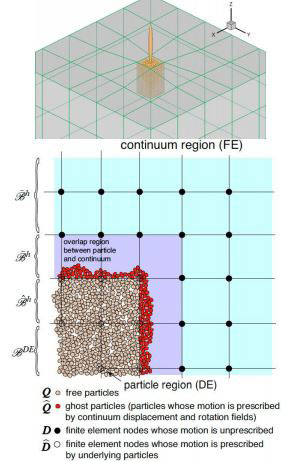Coupling Discrete and Finite Elements
University of Colorado at Boulder
Problems
Granular materials remain an unmastered class of materials with regard to modeling their spectrum of mechanical behavior in a physically-based manner across several orders of magnitude in length-scale. They may transition in an instant from deforming like a solid to flowing like a fluid or gas and vice versa. Examples of such physical transition are the flow of quartz grains around and at the tip of a driven cone penetrometer penetrating sand, or the shoveling of sand or gravel by a tractor bucket, for instance. These examples each involve material regions where relative neighbor particle motion is large (flowing like a fluid or gas) and regions where relative neighbor particle motion is small (deforming like a solid). It is too computationally intensive to account for over the whole spatial problem domain the grain-scale properties and intergranular constitutive behavior within a physics-based simulation (e.g., discrete element (DE) model) to understand fundamentally the mechanics in a large shear deformation interface region between deformable solid bodies and granular materials.
Approach
The focus of our research is to bridge grain-scale properties and mechanics to the macro-scale continuum behavior in a large shear deformation interface region between a deformable solid body (e.g., cone penetrometer skin, metal scoop, or rubber tire) and a dense dry cohesionless granular material (e.g., dry sand or gravel). A multiscale approach is used to provide fundamental physics-based simulation consisting of (i) finite element (FE) or rigid body mechanics for the solid body (penetrometer/scoop/tire) and DE for the granular material in the large shear deformation interface region, and (ii) FE-DE for the representation of the granular material in the transition/coupling region (bottom figure).

Findings
A penetration test is simulated quasi-statically to demonstrate artificial boundary effects on a DE simulation, and a preliminary attempt to alleviate these effects via coupling to FE facets (top figure). A penetrator is modeled using a large ellipsoidal particle penetrating a dense assembly of smaller ellipsoids, and the boundaries are composed of spherical particles, either fixed, or tied to a FE mesh (top figure). Elastic parameters for the particles are those of quartz, and contact constitutive behavior is nonlinear elastic Hertz-Mindlin and Coulomb frictional sliding. To examine the effect of DE-FE coupling on force-displacement curves of penetration, it is observed that the penetrator force of the small container with DE-FE coupling can be tuned to match the larger container with no coupling, by adjusting the elastic compliance of the FE continuum surrounding the container. The boundary effect difference observed will be partially or completely eliminated by applying a more robust DEFE coupling technique with overlapping particlecontinuum regions in future work (see bottom figure).
Impact
Ultimately, a fundamental understanding of granular physics interacting with a deformable solid body can lead to improved design of devices for granular soilmachine tool and soil-tire interaction, and the interpretation of granular soil-penetrometer shear resistance interaction. The multiscale computational mechanics approach presented is attempting to provide this understanding in conjunction with insitu x-ray computed tomography compression experiments on sand via a collaboration at Louisiana State University.
Core competencies
- Concurrent multiscale computational modeling of granular materials interfacing deformable solids involving finite elements and discrete elements.
- Finite strain micromorphic elastoplasticity and finite element implementation.
- Finite strain poromechanics for inelastic porous media and thin deformable porous materials.
- 3-D embedded strong discontinuity hexahedral finite element modeling of fracture and slip surfaces in geomaterials
Current research team members
- Richard Regueiro (Assistant Professor)
- Volkan Isbuga (Ph.D. Candidate)
- Jaehong Kim (Ph.D. Candidate)
- Wei Wang (Ph.D. Candidate)
- Sheng-Kai Yu (Ph.D. Candidate)
- Christopher Bay (BS/MS Undergraduate)
- Yevgeniy Kaufman (BS/MS Undergraduate)
Recent graduates and co-workers
- Beichuan Yan (Ph.D. 2008) Research Associate, Community Surface Dynamics Modeling System (CSDMS), University of Colorado at Boulder
- Garrett Sutley (M.S. 2009) Engineer. Bureau of Reclamation, Denver, CO.
- Davoud Ebrahimi (M.S. 2007) Ph.D. candidate, Massachusetts Institute of Technology.
Current research collaborations
- Khalid Alshibli, Louisiana State University, Xray synchrotron computed tomography of sands for calibration/validation of multiscale models.
- John Clayton, Army Research Laboratory, multiscale failure mechanics of particulate materials
- John McCartney, CU Boulder, PI for project on Soil-Structure Interaction in Geothermal Foundations
- Tom Giddings, Andy Hoenger, CU Boulder, cryo-electron microscropy and tomography of type IV collagen meshwork of ocular lens capsule tissue for multiscale model characterization


